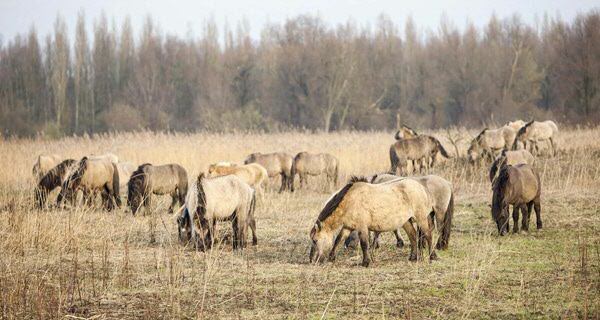Opinion: A natural mosaic
As has often been the case over the last 20 years, Oostvaardersplassen is once again simultaneously focal point, magnifying glass and mirror in the discussion about the relationship between humans and nature. Wageningen professor Frank Berendse seemed to have thrown in the towel when he suggested simply removing all the large herbivores from Oostvaardersplassen and submerging the entire area (Trouw, 9 March). As ecologist Frans Vera responded, this is not a long-term solution, because vegetation would colonize the area and turn it into carr within 10 years, causing birds native to young open reed marshes to disappear (Trouw, 22 March).
Other nonsensical arguments have been put forward in the media discussion, which at present is chiefly dominated by horse owners. It is not true that herbivore numbers and their mortality rate are getting out of hand. For some 10 years already, roughly the same number of herbivores have died as have been born in Oostvaardersplassen. This makes these cattle, horses and red deer no different from the red deer and wild boar in the Veluwe, and otters, seals, badgers and brent geese in the rest of the country. Supplementary feeding only leads to more animals and thus greater numbers and an even higher mortality rate. Campaigning against mortality is thus campaigning against young animals being born, and thus actually campaigning against the survival of all larger animals that live in the wild.

Concern about animal welfare in its current form seems to come from tunnel vision about animal welfare that is based on how to treat pet horses and farm animals. Animal welfare experts, who helped develop the present early-reactive management of Oostvaardersplassen as the most animal-friendly solution, have argued for years that animal welfare cannot be reduced to an abundance of food for 12 months of the year. Animal welfare stands for using natural adaptations, such as storing fat in periods of excess and burning this in periods of scarcity, adapting behaviour to the cold and food shortages, animals choosing their own partners, long-term social interaction in herds and natural selection, which means that the strongest animals survive and reproduce. Is it guilt about withholding many of these animal welfare aspects that has led horse lovers and livestock owners to try to reduce animal welfare to an abundance of food all year round? And does this mean that we should also give badgers, otters, porpoises and seals supplementary food?
It is clear that nature is in crisis in the Netherlands, mainly because of the industrialization of agriculture and the unrelenting urbanization of the country. This goes together with a growing distance between people and nature, the repercussions of which have given rise to the suggestion that we should apply the same standards that we apply to pets to wild animals too. The loss of biodiversity and landscape quality cannot be reversed by returning to an unproductive pre-1950s agriculture or by fighting new forms of nature from a misguided sense of compassion for animals.
The Netherlands needs a mosaic of sustainable, nature-inclusive agriculture and innovative nature development projects such as Oostvaardersplassen, in which threatened species find a permanent new home in varied, accessible landscapes that are affordable to maintain. It also needs creative area solutions in which new forms of natural climate buffering, flood protection, nature-oriented recreation and other ecosystem services go hand in hand with nature.
By professor Han Olff, Professor of Community and Conservation Ecology at the University of Groningen
More news
-
15 September 2025
Successful visit to the UG by Rector of Institut Teknologi Bandung
